Urban commuters living in cities around the world are all too aware of the extortionate cost of public transport. If you live in London, for instance, to navigate your way through the underground network from your house to the office, which is really just six miles away, will set you back over £1,000 for an annual pass. That money could be far better spent on a much more fun and accessible way of getting around the city – the Gocycle. This light and sleek bicycle, which is powered by conventional pedals as well as a high performance electric motor to give an added boost up hills, is the first bicycle in history whose frame is injection moulded in magnesium alloy. “The Gocycle is the fusion of my day-to-day experiences of living in London, my expertise in lightweight vehicle design, and my insight into the market opportunity of providing better city-specific mobility solutions,” explains its creator Richard Thorpe. “It’s not only fun, but it’s also hugely practical, if you’ve got a five-mile commute to work and you don’t want to get too hot in your best suit, it’s perfect.”
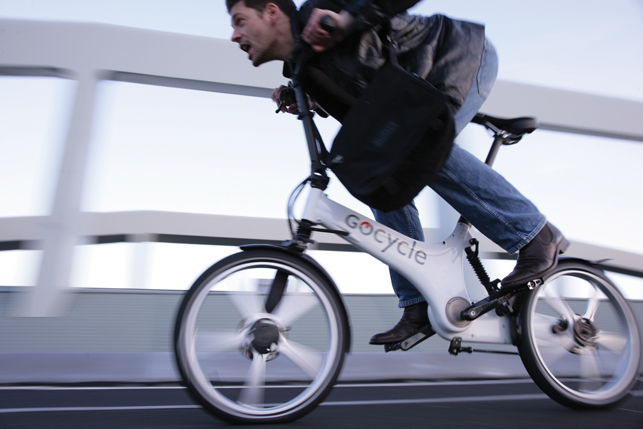
The Gocycle is new generation bike featuring a lightweight magnesium frame and electric motor so you don’t have to get all hot and sweaty on your way to work.
Having had to put up with dirty chain grease on his trousers and arriving at work hot and bothered, this former McLaren engineer founded his own company – Karbon Kinetics Limited (KKL) – in January 2002 with the aim of designing, developing and commercialising light electric vehicles. “I left McLaren Cars to get into light electric mobility – electric city cars and electric motorcycles, starting with an electric two-wheeler Gocycle,” says Thorpe. “The power plan for electric cars and motorcycles is still about five to ten years away but for cycles, the technology is absolutely right there.”
Material gains
Thorpe funded the business himself with help from friends and family and initially thought he would create his Gocycle using carbon fibre. However, having created prototypes of the frame it was decided that this process was just too expensive as each bicycle would have to sell for around £3,000. It was then that he started to look at alternative material technologies.
“We qualified for a Department of Trade and Industry grant to develop the alternative magnesium moulding technology which delivered total cost breakthrough,” says Thorpe. The process he researched to create Gocycle’s frame is known as thixomoulding, a type of injection moulding for metal. “Laptops, digital cameras and mobile phones have used thixomoulding to produce the magnesium casings, which are more durable than plastic,” he points out. “However, as the machines that produce the parts have gotten bigger, the technology has started to be looked at by automotive and aerospace companies because of the finer grain structure and better mechanical properties for fatigue resistance.” Thixomoulding is also a more environmentally friendly process than traditional die-casting as it produces less harmful gases and because it is injection moulded in a semi solid state, there is also a lower energy usage.
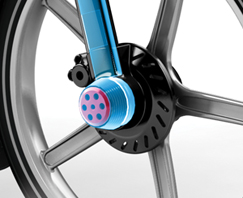
The Gocycle’s micro-sized electric motor provides on-demand power at the touch of a button when your legs don’t work anymore
Supply chain
Thorpe took his groundbreaking idea to bicycle manufacturers. “I spent a year and a half travelling the globe with my kit to pitch the idea to the cycle industry to say ‘look, you can use this technology and make much better looking and more functional products’,” he says. “There was pretty much rejection across the board because the technology was too unproven and the tooling was very expensive.” So, he returned to the UK and created a business plan to launch the product himself. “We went through our own sort of ‘Dragon’s Den’ and in January 2006 we closed our first round of funding with angel investors and from then we went back to the cycle industry and said ‘we’ll pay for all the tooling and take all the risk out of the equation from magnesium parts if you, as a partner, assemble the bicycle for us and front our inventory,” he explains.
This deal worked and in May 2006 KKL formed a strategic partnership with Ideal Bike Corp in Taiwan to produce the first pilot run of 200 Gocycles, which are now under evaluation with customers throughout the world.
At that time KKL was really just a virtual company essentially consisting of one design engineer (Thorpe) with one computer and one seat of Pro/Engineer. He used a lot of Internet tools for sourcing all the components from around the world. Eventually, an agreement was made with a tier one auto supplier, a Canadian firm called G-Mag, to produce the groundbreaking injection moulded magnesium frame components and, according to Thorpe, with its 1,000 tonne moulding machine, it’s the only company in the world with a machine big enough to make the parts. “We have a complex worldwide supply chain with about 20 suppliers from China, Taiwan, Czech Republic, USA and Canada,” he comments.
Product development
When it came to the design process the Gocycle was entirely developed in Pro/E. “Probably for about fifteen years I have been involved in hobby cycle design and engineering and for me as a design engineer, sketching has become redundant and everything is a 3D model,” explains Thorpe. So, the process began with a skeleton in the main assembly and parts were just added and assembled in a default condition with the whole model being interrelated. “Pro/E just works. You chug away, feature after feature, component after component, with consistent productivity. It is one of the most robust software platforms I have used,” he says.

Hard case for the Gocycle
Thorpe pretty much knows all the parts in the main assembly, which consists of roughly 750 components, and has continually changed and modified his model. “The main frame has been regenerated probably for four years – there hasn’t been a new creation of a part. I am able to continually modify those,” says Thorpe. “We cut production tooling after about six prototypes because we spent so much time modelling and regenerating.” In fact, he feels that one of Pro/E’s strengths is its ability to regenerate models. He remembers recently having to alter a wall thickness that was deep in the model tree at about feature 30 with over 500 downstream features on top of it.
Suspecting days of what he refers to as ‘Regeneration Hell’, which means having to lock himself in his flat for three days solid attempting to regenerate his model, instead he edited the feature and within two hours it regenerated through the whole model tree. “Parametric regeneration is just unbelievable – the amount of times I have stepped back and thought ‘jeepers creepers, how does it do that?’,” smiles Thorpe.
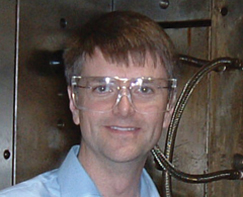
In order to produce a bike that was light and strong, yet still affordable, Richard Thorpe, the brains behind the Gocycle, utilised a new magnesium moulding technology called thixomoulding, a type of injection moulding for metal more commonly used for laptops, digital cameras and mobile phones
Another area where Pro/E shone for Thorpe was in the exporting of data. “Probably the most functionality or benefit we get from Pro/E is it’s so absolutely reliable in exporting data. I export still with DXF Version 12 but I never ever have a problem and never have a problem with the STEP files either,” says Thorpe. “For a company like ours, where there are very few people involved, we are really able to punch above our weight in terms of efficiencies for exporting.”
Thorpe’s aim was to create a clean, seamless design that relied heavily on moulded construction methods as opposed to welding and fabrication technology. So, besides thixomoulding magnesium KKL also used very high glass content injection moulded plastics. “This is very unusual for the cycle industry because of the strength, weight and safety requirements,” explains Thorpe. He approached Shropshire-based Protomold to help injection mould this lightweight yet strong material, which incorporates 60 per cent glass. Protomold’s engineering team was uncertain as to how well the material would flow and pervade the cavity within the injection-moulding tool however, having analysed the various pressure and temperature conditions required to achieve successful component moulding, it developed a total of 47 individual injection-moulding tools, which were used to manufacture the required parts. “Again, an emphasis on moulding for look and feel, for weight and performance aspects and also for cost savings – it’s the most efficient process you can get really for a consumer product,” says Thorpe. “Bicycles are one of the most competitive markets in the world and to deliver a product like this with the look and feel we were looking for at an affordable, competitive price is quite a challenge.”
For me as a design engineer, sketching has become redundant and everything is a 3D model
Show stopper
In 2007 KKL produced and assembled 200 Gocycles at Ideal Bike Corp. The ‘breakthrough models’ from this first production run were given to ‘Gocycle pioneers’ all over the world for evaluation. “Low cost, low emissions, high performance. An urban essential,” said a pioneer in Shropshire. Another in Johannesburg, South Africa, who had used it to commute 20 minutes to work, enthused: “I love the styling, the comfort and the fact that when I am out of breath I can crank the motor on and power up the hills.”
The Gocycle made its debut at the Taipei Cycle show in March 2008 and bagged first place in two categories – overall bicycle and best innovation, beating off tough competition including, rather ironically, the bicycle manufacturers who had rejected his idea a number of years before. “To sit there and have a product win the awards after you have done a production run is quite a bit more satisfying than winning an award with a prototype,” says Thorpe. “Having said that it’s a hell of a challenge for the business to launch in the current climate. One thing that’s good is it’s got pedals and we can prove to people that it’s less expensive on a Gocycle than on the Underground.”
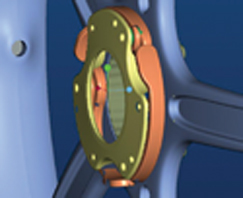
The Gocycle was developed entirely in Pro/Engineer
Moving up a gear
KKL is currently engaged in the second production with market launch and 3,000 Gocycles expected to be available in April 2009. However, not all has gone smoothly as there were many challenges for Thorpe to deal with having production and assembly in Taiwan and the transition from that breakthrough period into a full-fledged business supply contract didn’t quite work out. As a result, everything is now coming into the UK and the Gocycle will be assembled in two companies – one near Cambridge and the other in Birmingham, which is a Tier 1 auto supplier. So, today KKL operates and manages the entire value chain from design to sourcing of components, automated assembly and production in the UK, to testing, marketing, sales and customer care.
Gocycle will be sold directly to the customers via the website requiring some basic assembly. “Another aspect of the business is that we say its Apple design and Dell distribution,” Thorpe explains. “We are going to have a dealer channel as well where fully assembled Gocycles can be purchased but the primary focus is delivering our product and our message straight to the consumer.” So, the Gocycle can be pre-ordered now directly from www.gocycle.com and although it would usually set you back £1,158, if you pre-order before 31st March you can get your hands on one for £999.
After six years of design and development and a lot of hard work, Thorpe is eventually seeing his product come to market. KKL will also be expanding from essentially ‘a one man band’ into a proper business with a number of new hirings on the way. He is especially on the look out for some good Pro/E designers and engineers. “It has been a very big learning curve for me and a challenge,” says Thorpe, who envisages work to continue on the Gocycle to make it even lighter as battery technology develops. So, as they say, watch this space.
www.gocycle.com
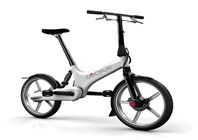
Karbon Kinetics brings power to the pedal with Gocycle






